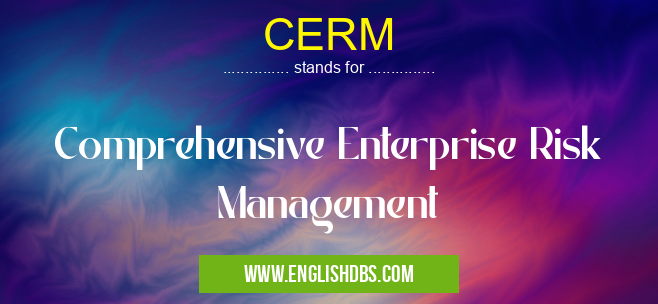What does CERM mean in MANAGEMENT
Comprehensive Enterprise Risk Management (CERM) is a multi-disciplinary approach to managing risk for an organization. It is based on the idea that business success depends on how well the organization is able to identify, assess, and manage risk. CERM helps organizations develop comprehensive risk management processes and strategies that can be used to effectively manage any potential risks they may encounter. CERM also provides organizations with a framework for developing and implementing effective processes related to governance, monitoring, assessment, control and review of its risk management programs.

CERM meaning in Management in Business
CERM mostly used in an acronym Management in Category Business that means Comprehensive Enterprise Risk Management
Shorthand: CERM,
Full Form: Comprehensive Enterprise Risk Management
For more information of "Comprehensive Enterprise Risk Management", see the section below.
» Business » Management
Benefits Of Implementing A CERM System
Implementing CERMComprehensive Enterprise Risk Management (CERM) has numerous advantages for organizations looking to successfully manage their risks into the future. The key benefits include: * Improved visibility into current and potential risks across an enterprise; * Greater understanding of how different activities interact with each other; * Increased accountability in managing organizational activities; * Enhanced communication between stakeholders; * Increased efficiency in responding quickly to change; * More accurate budgeting based on accurate forecasting models; * Ability to make smarter decisions by addressing potential areas of vulnerability quickly; * Greater ability to measure and track progress against goals.
Essential Questions and Answers on Comprehensive Enterprise Risk Management in "BUSINESS»MANAGEMENT"
What is Comprehensive Enterprise Risk Management?
Comprehensive Enterprise Risk Management, or CERM, is an approach to analyzing and managing risk that recognizes the interdependence of multiple risk factors in any enterprise environment. It seeks to identify, quantify, and manage potential risks across all operations within a company or organization. CERM can also be used to map out the relationships between stakeholders in order to optimize business strategies and decision making.
What are the benefits of CERM?
CERM enables organizations to reduce risk exposure while simultaneously maximizing opportunities for growth through strategic planning and decision-making. By having a comprehensive understanding of risks throughout an organization, better decisions can be made with a greater degree of accuracy. Additionally, it allows organizations to respond quickly and efficiently when unexpected events occur--such as economic downturns or market fluctuations--in order to minimize disruption or loss of profits.
How does CERM differ from traditional risk management approaches?
Unlike traditional risk management approaches which focus solely on financial risks, CERM takes a holistic view of an organization's enterprise risk portfolio by including operational, legal, environmental and other non-financial risks as well. The comprehensive nature of this approach allows organizations to make more informed decisions about where resources should be allocated in order to maximize value and minimize losses. Additionally, CERM can be used in both pre-emptive efforts (such as forecasting) as well as reactive ones (such as incident response).
What kind of organizational problems can CERM help address?
Since CERM takes a broad scope view of all aspects within an organization, it gives businesses the ability to identify sources of potential losses so they may take proactive steps towards resolving those issues before they become problems. This could include anything from security vulnerabilities that could lead to data breaches or compliance violations which could result in regulatory fines or reputational damage. As such, it ensures that organizational processes are properly managed with built-in resilience against unexpected market shifts or unforeseen events which can cause significant disruption and improper performance if not addressed appropriately.
What role does technology play in implementing CERM?
Technology plays an important role when it comes to implementing a successful comprehensive enterprise risk management strategy because it simplifies large amounts of data into easily actionable insights that enable businesses to better understand their risk exposures so they may adjust their strategies accordingly in order to achieve their goals effectively and efficiently. Technology also makes incorporating new data sources into existing models easier and supports automation so frequent updates can be made without manual intervention--enabling faster response times when critical situations arise.
How long does it take for organizations to adopt CERM?
The length of time required for full adoption depends on the complexity and size of the organization’s processes but generally speaking most organizations are able to have at least some level of CERM implementation within 6-12 months once they have identified their key objectives and have begun making necessary changes (e.g., reorganizing teams/processes). Additionally, depending on need some elements may require ongoing maintenance even after full adoption has been achieved while others may only need periodic reviews based on operational requirements or external changes such as new regulations affecting operations.
Is there any cost associated with implementing CERM?
Yes, there are typically costs associated with implementing any type of enterprise risk management system due mainly personnel costs for training employees on how use new systems/processes coupled with investments into software solutions required support them; however these costs are typically offset by the savings found through operational efficiencies brought about by such measures.
Final Words:
In conclusion, Comprehensive Enterprise Risk Management (CERM) provides businesses with a structured approach for assessing and managing risk within their organization. By implementing this system businesses can gain significant benefits such as improved visibility into potential risks across the enterprise as well as increased efficiency regarding decision making abilities. This allows them to strategically allocate resources more accurately while also ensuring their operations remain secure.
CERM also stands for: |
|
| All stands for CERM |
